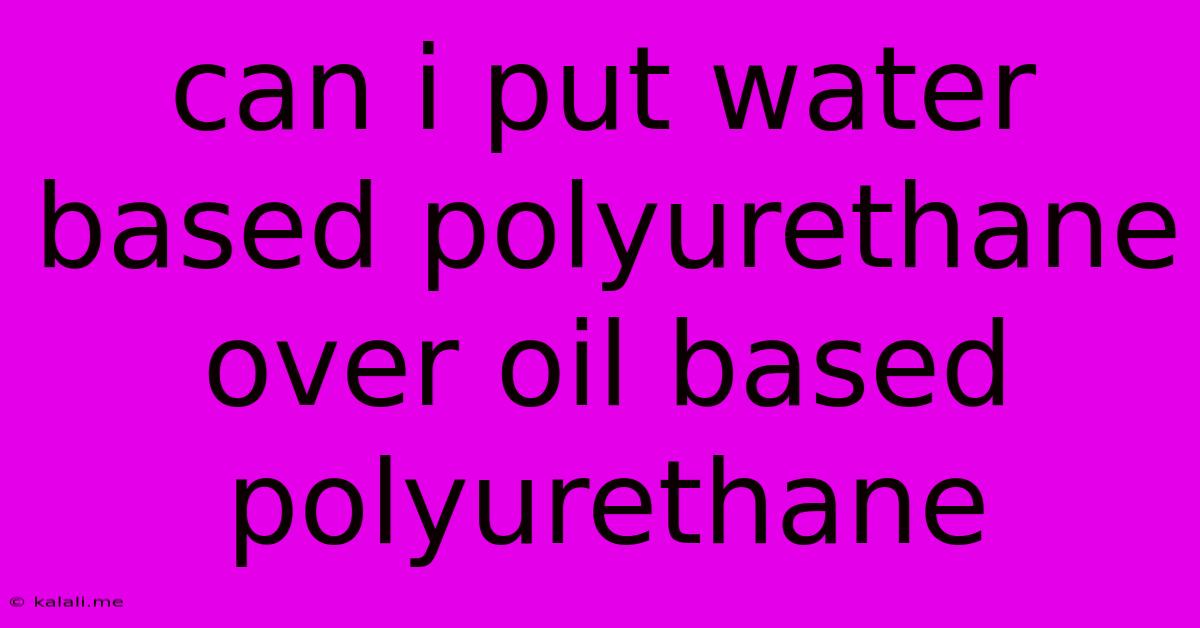Can I Put Water Based Polyurethane Over Oil Based Polyurethane
Kalali
Jun 04, 2025 · 3 min read

Table of Contents
Can You Put Water-Based Polyurethane Over Oil-Based Polyurethane? The Definitive Guide
Meta Description: Wondering if you can apply water-based polyurethane over oil-based polyurethane? This comprehensive guide explores the compatibility, potential problems, and best practices for this tricky finish layering. Discover the right approach to achieve a smooth, durable surface.
Applying a finish to wood is a crucial step in protecting and enhancing its beauty. Polyurethane, in both water-based and oil-based varieties, is a popular choice. But what happens when you need to reapply or add a layer, and you're dealing with different types? The question many woodworkers grapple with is: can you put water-based polyurethane over oil-based polyurethane? The short answer is generally no, and this article will explain why.
Understanding the Chemical Differences
The core issue lies in the fundamental chemical differences between oil-based and water-based polyurethanes. Oil-based polyurethane is, as its name suggests, oil-based. It cures through a process of oxidation, meaning it hardens by reacting with oxygen in the air. Water-based polyurethane, on the other hand, cures through evaporation of water and a chemical reaction.
This difference in curing mechanisms makes them incompatible. The oil-based layer beneath will not allow the water-based polyurethane to properly adhere. This leads to several potential problems.
Potential Problems of Layering Incompatibly
Attempting to apply water-based polyurethane over oil-based polyurethane often results in:
- Poor Adhesion: The water-based layer will likely peel, chip, or otherwise fail to adhere properly to the underlying oil-based layer. This is the most significant problem.
- Blooming or Fisheye: The water in the water-based polyurethane can react with the oil-based layer, causing a cloudy or hazy appearance known as blooming or fisheye.
- Uneven Finish: The resulting finish will be uneven, bumpy, and aesthetically unpleasing.
- Weakened Protection: A poorly adhered topcoat provides significantly less protection to the wood underneath, making it vulnerable to damage.
Alternatives and Best Practices
Instead of attempting to layer incompatible finishes, consider these alternatives:
- Sanding and Re-coating with Oil-Based Polyurethane: The best solution is often to lightly sand the existing oil-based polyurethane to roughen the surface, ensuring better adhesion for another coat of oil-based polyurethane. Always use fine-grit sandpaper (220-grit or higher) to avoid scratching the surface. Wipe clean with a tack cloth before applying a new coat.
- Complete Removal of Existing Finish: For a more thorough approach, you can remove the existing oil-based polyurethane completely using chemical strippers. This allows you to start fresh with either an oil-based or water-based polyurethane, depending on your preference. Remember to follow safety precautions when using chemical strippers.
- Choosing a Compatible Finish: Before starting a project, ensure you're using compatible finishes. If you begin with an oil-based polyurethane, stick with oil-based for future coats. Similarly, stay consistent with water-based products if you've started with them. Planning ahead prevents these compatibility issues.
Choosing the Right Polyurethane: Water-Based vs. Oil-Based
Both water-based and oil-based polyurethanes have advantages and disadvantages:
-
Water-Based Polyurethane: Low odor, easy cleanup with soap and water, faster drying time, and less yellowing over time. However, it might not be as durable as oil-based polyurethane in high-traffic areas.
-
Oil-Based Polyurethane: More durable and provides a harder finish. However, it has a strong odor, requires mineral spirits for cleanup, and may yellow over time.
In conclusion, while tempting to mix and match, applying water-based polyurethane over oil-based polyurethane is generally not recommended. The potential for poor adhesion, blooming, and an unsatisfactory finish outweighs any perceived convenience. Choosing compatible finishes from the start, or properly preparing the surface for recoating, ensures a successful and long-lasting finish. Remember to always refer to the manufacturer's instructions on your specific polyurethane product.
Latest Posts
Latest Posts
-
Dado Blade For 10 Table Saw
Jun 06, 2025
-
Jesus Washed The Feet Of His Disciples
Jun 06, 2025
-
How To Remove Background On Gimp
Jun 06, 2025
-
How Do Heat Pumps Work In Winter
Jun 06, 2025
-
Is White Wine Vinegar The Same As White Cooking Wine
Jun 06, 2025
Related Post
Thank you for visiting our website which covers about Can I Put Water Based Polyurethane Over Oil Based Polyurethane . We hope the information provided has been useful to you. Feel free to contact us if you have any questions or need further assistance. See you next time and don't miss to bookmark.